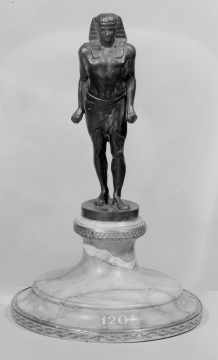Explore Collections


You are here:
CollectionsOnline
/
Statuette of the Egyptian Antinous
Browse
Curatorial note
In this statuette Antinous stands squarely, left foot slightly ahead of the right, in the classical Egyptian pose, arms at sides, fists closed about staffs in his hands. He wears the royal headress with lappets on the shoulders and chest and a folded Egyptian loincloth about the waist.
A letter sent from Rome Feb. 15, 1795 by C.H. Tatham to Henry Holland encloses a sketch of a similar figure used as a three-branched candlestick support (as the threaded hole in the head of this piece would indicate) and indicates that such bronze candelabra could be commissioned of the contemporary Roman bronze-makers for£10. This statuette appears to be the central figure from such an ensemble, set on a base different from the sphinx-supported pedestal shown in the Tatham drawing.
Tatham's letter no. 4, July 10, 1795, continues the subject of acquisition of such articles in Rome and seems to indicate that this particular candelabrum design was the product of one Antonio Righetti, whose dealings with English clients were so extensive that he was able to quote prices in sterling. Tatham characterizes Righetti and Giuseppe Valadier, who also manufactured such articles, as "proprietors of an extensive trade in bronzes and the principals in Rome". The man from whom Tatham commissioned bronze decorative figures, however, was Giuseppe Boschi, "an obscure artist here whose designs as well as prices, both for merit and reasonable demand induced me to procure them." On several occasions Tatham submitted estimates for the same orders to all three separately, and in all cases Righetti was the most expensive, while Boschi's prices were considerably under those of Valadier.
While cross-composed from the Egyptian Antinous of the Vatican1, the suggestion for use as a candelabrum comes from the Ptolemaic red granite "Cisci" from Tivoli and Hadrian's Villa - now in the Sala a Croce Greca of the Museo Vaticano2.
1 Gusman, Villa Hadriana, p. 309f., fig. 559.
2 Gusman, Villa Hadriana, p. 317, fig. 586.
A letter sent from Rome Feb. 15, 1795 by C.H. Tatham to Henry Holland encloses a sketch of a similar figure used as a three-branched candlestick support (as the threaded hole in the head of this piece would indicate) and indicates that such bronze candelabra could be commissioned of the contemporary Roman bronze-makers for£10. This statuette appears to be the central figure from such an ensemble, set on a base different from the sphinx-supported pedestal shown in the Tatham drawing.
Tatham's letter no. 4, July 10, 1795, continues the subject of acquisition of such articles in Rome and seems to indicate that this particular candelabrum design was the product of one Antonio Righetti, whose dealings with English clients were so extensive that he was able to quote prices in sterling. Tatham characterizes Righetti and Giuseppe Valadier, who also manufactured such articles, as "proprietors of an extensive trade in bronzes and the principals in Rome". The man from whom Tatham commissioned bronze decorative figures, however, was Giuseppe Boschi, "an obscure artist here whose designs as well as prices, both for merit and reasonable demand induced me to procure them." On several occasions Tatham submitted estimates for the same orders to all three separately, and in all cases Righetti was the most expensive, while Boschi's prices were considerably under those of Valadier.
While cross-composed from the Egyptian Antinous of the Vatican1, the suggestion for use as a candelabrum comes from the Ptolemaic red granite "Cisci" from Tivoli and Hadrian's Villa - now in the Sala a Croce Greca of the Museo Vaticano2.
1 Gusman, Villa Hadriana, p. 309f., fig. 559.
2 Gusman, Villa Hadriana, p. 317, fig. 586.
Rome - see below
Soane collections online is being continually updated. If you wish to find out more or if you have any further information about this object please contact us: worksofart@soane.org.uk




